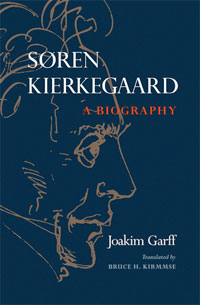Book Notes
 Joakim Garff, Soren Kierkegaard; A Biography, translated by Bruce H. Kirmmse (Princeton: Princeton University Press, 2005), 867pp.
Joakim Garff, Soren Kierkegaard; A Biography, translated by Bruce H. Kirmmse (Princeton: Princeton University Press, 2005), 867pp.
First published in Denmark in 2000, Joakim Garff's massive and monumental biography of the "melancholy Dane" makes its English debut just in time to commemorate Kierkegaard's death exactly 150 years ago ( November 11, 1855). Anyone who has taken a college freshman class in western civilization or philosophy has a vague familiarity with the name, if not his thought, and some have even dared to tackle his complicated and brilliant work of "indirect" communication via pseudonyms and his later "direct" (and was it ever direct!) communication under his own name. In grad school I took a turn at Kierkegaard, and even now in my office there hangs a poem by him thanks to my wife's calligraphy:
Herr! gieb uns blöde Augen (Lord, give us weak eyes)
für Dinge, die nichts taugen, (for things that do not matter)
und Augen voller Klarheit (and eyes full of clarity)
in alle deine Wahrheit! (in all your truth!)
Kierkegaard prefaced his work The Sickness Unto Death with this prayer-poem.
Although a wild diversity of interpreters from existentialism to deconstructionism has claimed Kierkegaard as their own, and although SK's personality and complex oeuvre present any biographer with an extraordinarily difficult task, Garff shows that he is rightly understood as an artist-poet whose focus was distinctly and deliberately religious. He treats the reader to large doses of SK himself, and reviews all his major writings and journals, focusing on Kierkegaard's life and not really his thought. In this sense he treats Kierkegaard personally rather than intellectually or theologically. He starts with his early years, and proceeds year by year. I would have enjoyed an epilogue that took a stab at Kierkegaard's ecclesiastical, pastoral, and theological legacy. How did a writer in backwater Denmark whose books had print runs of 500 copies (only one of which sold out), whose grave remained unmarked for twenty years after his death, and who barely traveled, emerge as one of the most seminal thinkers of Christian history?
Throughout his short life (1813–1855) Kierkegaard battled a pronounced and chronic melancholia that resulted from a number of factors—his pietistic and stern father, his public humiliation in Copenhagen's rollicking newspaper the Corsair, his sense of victimization, his scathing denunciation of the Church of Denmark's chief bishop (Mynster), and his broken engagement with Regina Olsen. His hypochondria did not help, nor did his estrangement from his lone surviving sibling (his five siblings and mother all died by the time Kierkegaard was about 20). For much of his life, he tells us, through a monumental effort of repression, diversion, and displacement, Kierkegaard distracted and protected himself from his melancholia through his prodigious writing. And there is no doubt that his melancholia served as a fund for enormous artistic creativity and interior reflection (a fact not lost on psychiatrist Peter Kramer in his recent book Against Depression). Writing was his therapy, he once observed: "I saved my life by telling stories." Like Mozart, he just might have been the artistic genius whose sickly body could hardly contain its pulsating brilliance.
What infuriated Kierkegaard was pious pretense, intellectual sophistry, the evisceration of the radical Gospel, and a bourgeois religiosity that tamed Christianity of what he called its "terror." The state-paid clergy, he sneered, derived social and financial gain from the Gospel: "In the splendid cathedral, the high, well-born, highly honored, and worthy Geheime-General-Ober-Hof-Preacher, the chosen darling of the important people, steps before a select circle of the select, and movingly sermonizes on a text chosen by himself, namely, 'God has chosen the lowly and despised of the earth'—and no one laughs" (p. 773). Since no one laughed at the discrepancy between genuine Christianity and the pale imitation of cultural Christendom, Kierkegaard intended to provoke a collision or catastrophe between the two. This was train wreck by design. He was an agitator and pyromaniac who employed his literary brilliance to utilize satire as an act of arson: "I am the one who has set the fire in order to smoke out illusions and trickery" (p. 774).
Garff honors his subject but does not ignore his faults. Kierkegaard could be unctuous, petty, shrill, cynical, inaccessible to anyone he did not care to see, and vindictive. One subject of his lethal pen lamented, "he could make you feel small." His father was one of the wealthiest people in Denmark, and it was not lost on his critics that Kierkegaard never worked while he enjoyed an extravagant lifestyle. But he had little money at his death, and financed most of his own publications. One observer complained that while Jesus cried over Jerusalem, Kierkegaard employed dripping sarcasm to laugh at the church.
There is something like a scorched-earth smell in Kierkegaard. It is hardly news that the church "swarms with many faults" (John Calvin). I rather like the choice of the feminist Catholic writer Joan Chittister who describes herself as a "loyal member of a dysfunctional family." Still, we can thank Kierkegaard for never letting us forget the ideal, how far and so self-servingly we fail it, and forcing us to consider what it might mean for each one of us as a "single individual" whom he addressed.


